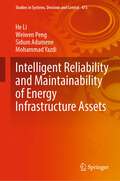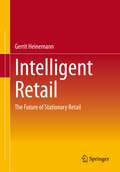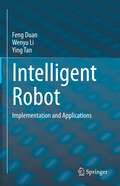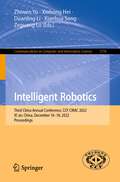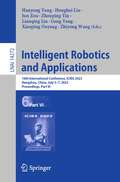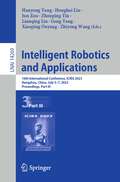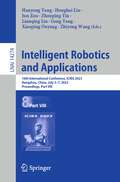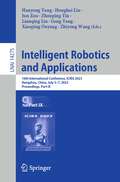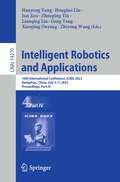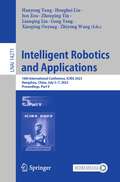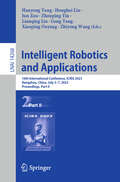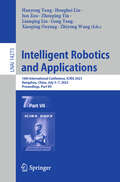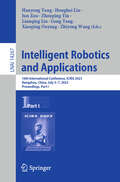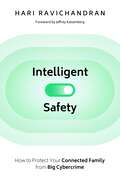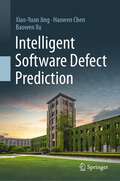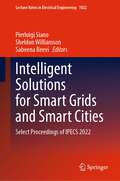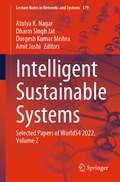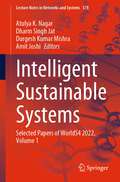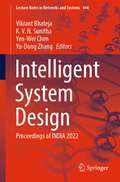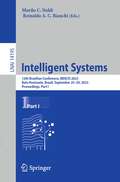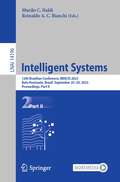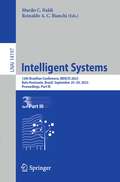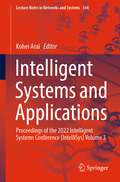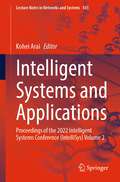- Table View
- List View
Intelligent Reliability and Maintainability of Energy Infrastructure Assets (Studies in Systems, Decision and Control #473)
by He Li Weiwen Peng Sidum Adumene Mohammad YazdiThis book reviews and presents several advanced approaches to energy infrastructure assets' intelligent reliability and maintainability. Each introduced model provides case studies indicating high efficiency, robustness, and applicability, allowing readers to utilize them in their understudy intelligent reliability and maintainability of energy infrastructure assets domains. The book begins by reviewing the state-of-the-art research on the reliability and maintainability of energy infrastructure assets and emphasizes the intelligent tools and methods proposed from a bibliometric and literature review point of view. It then progresses logically, dedicating a chapter to each approach, dynamic Bayesian modeling network, convolutional neural network model, global average pooling-based convolutional Siamese network, an integrated probabilistic model for the failure consequence assessment, and more. This book interests professionals and researchers working in reliability and maintainability and postgraduate and undergraduate students studying intelligent reliability applications and energy infrastructure assets' maintainability.
Intelligent Retail: The Future of Stationary Retail
by Gerrit HeinemannThis book shows stationary retail a way to reinvent itself after Corona, in order to be able to survive against the strong competition of online retail. The focus is on the central issues that will shape the retail of the future. For example, brick-and-mortar retail in particular must now work with intelligent systems based on data and adopt or even surpass methods that the large online marketplaces have been using successfully for a very long time. In this regard, artificial intelligence also plays a major role in retail. This is not just about automation and robots taking over tasks, but also about instruments and machines being able to learn and draw conclusions themselves in all retail functions. This is becoming increasingly difficult because our shopping and search behavior is constantly changing. Therefore, a customer should receive intelligent recommendations in the store, which are also based on his already known interests and behavior patterns. Gerrit Heinemann shows how intelligent action can save stationary retail in city centres and shopping centres.The content - From stationary Retail to intelligent Retail - Threats to the stationary retail trade - Basic requirements and manifestations of intelligent Retail - Examples of intelligent retail of the future - Risks for intelligent Retail
Intelligent Robot: Implementation and Applications
by Ying Tan Feng Duan Wenyu LiToday, the development of robots is making steady advances. In particular, the Robot Operating System (ROS) offers a unified platform that greatly facilitates the development of robots and has become a new hotspot for learning and application in the field of robotics research.This book introduces readers to the key technologies and development methods for ROS-based intelligent robots. Covering both the development history of robots and various aspects of programming robots, it offers effective support for beginners.The book is divided into three parts, the first of which introduces the basics of robots, including their definition, development, composition, and key technologies. In turn, the second part covers the hardware and software components and the implementation of functions such as vision, speech, grasping, and autonomous navigation. These functions need to work together to provide user-friendlier and more intelligent service. The third part shows how to develop robots with different functions in different application scenarios.Combining theoretical and practical aspects, with a strong focus on application, this work can be used as a reference book for robotics-related courses. Moreover, it will benefit all readers who are interested in intelligent robot development, sharing essential insights into developing service robots based on ROS.
Intelligent Robotics: Third China Annual Conference, CCF CIRAC 2022, Xi’an, China, December 16–18, 2022, Proceedings (Communications in Computer and Information Science #1770)
by Zhiwen Yu Xinhong Hei Duanling Li Xianhua Song Zeguang LuThis book constitutes selected papers presented during the Third China Annual Intelligent Robotics Conference, CCF CIRAC 2022, held in Xi' an, China, in December 2022. The 35 papers presented were thoroughly reviewed and selected from the 120 qualified submissions. They are organized in the following topical sections: robot safety; intelligent robot sensing; autonomous robot navigation; artificial intelligence and cloud robot; unmanned cluster collaboration; natural human-computer interaction; other robot-related technologies.
Intelligent Robotics and Applications: 16th International Conference, ICIRA 2023, Hangzhou, China, July 5–7, 2023, Proceedings, Part VI (Lecture Notes in Computer Science #14272)
by Huayong Yang Honghai Liu Jun Zou Zhouping Yin Lianqing Liu Geng Yang Xiaoping Ouyang Zhiyong WangThe 9-volume set LNAI 14267-14275 constitutes the proceedings of the 16th International Conference on Intelligent Robotics and Applications, ICIRA 2023, which took place in Hangzhou, China, during July 5–7, 2023.The 413 papers included in these proceedings were carefully reviewed and selected from 630 submissions. They were organized in topical sections as follows:Part I: Human-Centric Technologies for Seamless Human-Robot Collaboration; Multimodal Collaborative Perception and Fusion; Intelligent Robot Perception in Unknown Environments; Vision-Based Human Robot Interaction and Application.Part II: Vision-Based Human Robot Interaction and Application; Reliable AI on Machine Human Reactions; Wearable Sensors and Robots; Wearable Robots for Assistance, Augmentation and Rehabilitation of Human Movements; Perception and Manipulation of Dexterous Hand for Humanoid Robot.Part III: Perception and Manipulation of Dexterous Hand for Humanoid Robot; Medical Imaging for Biomedical Robotics; Advanced Underwater Robot Technologies; Innovative Design and Performance Evaluation of Robot Mechanisms; Evaluation of Wearable Robots for Assistance and Rehabilitation; 3D Printing Soft Robots.Part IV: 3D Printing Soft Robots; Dielectric Elastomer Actuators for Soft Robotics; Human-like Locomotion and Manipulation; Pattern Recognition and Machine Learning for Smart Robots.Part V: Pattern Recognition and Machine Learning for Smart Robots; Robotic Tactile Sensation, Perception, and Applications; Advanced Sensing and Control Technology for Human-Robot Interaction; Knowledge-Based Robot Decision-Making and Manipulation; Design and Control of Legged Robots.Part VI: Design and Control of Legged Robots; Robots in Tunnelling and Underground Space; Robotic Machining of Complex Components; Clinically Oriented Design in Robotic Surgery and Rehabilitation; Visual and Visual-Tactile Perception for Robotics.Part VII: Visual and Visual-Tactile Perception for Robotics; Perception, Interaction, and Control of Wearable Robots; Marine Robotics and Applications; Multi-Robot Systems for Real World Applications; Physical and Neurological Human-Robot Interaction.Part VIII: Physical and Neurological Human-Robot Interaction; Advanced Motion Control Technologies for Mobile Robots; Intelligent Inspection Robotics; Robotics in Sustainable Manufacturing for Carbon Neutrality; Innovative Design and Performance Evaluation of Robot Mechanisms.Part IX: Innovative Design and Performance Evaluation of Robot Mechanisms; Cutting-Edge Research in Robotics.
Intelligent Robotics and Applications: 16th International Conference, ICIRA 2023, Hangzhou, China, July 5–7, 2023, Proceedings, Part III (Lecture Notes in Computer Science #14269)
by Huayong Yang Honghai Liu Jun Zou Zhouping Yin Lianqing Liu Geng Yang Xiaoping Ouyang Zhiyong WangThe 9-volume set LNAI 14267-14275 constitutes the proceedings of the 16th International Conference on Intelligent Robotics and Applications, ICIRA 2023, which took place in Hangzhou, China, during July 5–7, 2023.The 413 papers included in these proceedings were carefully reviewed and selected from 630 submissions. They were organized in topical sections as follows:Part I: Human-Centric Technologies for Seamless Human-Robot Collaboration; Multimodal Collaborative Perception and Fusion; Intelligent Robot Perception in Unknown Environments; Vision-Based Human Robot Interaction and Application.Part II: Vision-Based Human Robot Interaction and Application; Reliable AI on Machine Human Reactions; Wearable Sensors and Robots; Wearable Robots for Assistance, Augmentation and Rehabilitation of Human Movements; Perception and Manipulation of Dexterous Hand for Humanoid Robot.Part III: Perception and Manipulation of Dexterous Hand for Humanoid Robot; Medical Imaging for Biomedical Robotics; Advanced Underwater Robot Technologies; Innovative Design and Performance Evaluation of Robot Mechanisms; Evaluation of Wearable Robots for Assistance and Rehabilitation; 3D Printing Soft Robots.Part IV: 3D Printing Soft Robots; Dielectric Elastomer Actuators for Soft Robotics; Human-like Locomotion and Manipulation; Pattern Recognition and Machine Learning for Smart Robots.Part V: Pattern Recognition and Machine Learning for Smart Robots; Robotic Tactile Sensation, Perception, and Applications; Advanced Sensing and Control Technology for Human-Robot Interaction; Knowledge-Based Robot Decision-Making and Manipulation; Design and Control of Legged Robots.Part VI: Design and Control of Legged Robots; Robots in Tunnelling and Underground Space; Robotic Machining of Complex Components; Clinically Oriented Design in Robotic Surgery and Rehabilitation; Visual and Visual-Tactile Perception for Robotics.Part VII: Visual and Visual-Tactile Perception for Robotics; Perception, Interaction, and Control of Wearable Robots; Marine Robotics and Applications; Multi-Robot Systems for Real World Applications; Physical and Neurological Human-Robot Interaction.Part VIII: Physical and Neurological Human-Robot Interaction; Advanced Motion Control Technologies for Mobile Robots; Intelligent Inspection Robotics; Robotics in Sustainable Manufacturing for Carbon Neutrality; Innovative Design and Performance Evaluation of Robot Mechanisms.Part IX: Innovative Design and Performance Evaluation of Robot Mechanisms; Cutting-Edge Research in Robotics.
Intelligent Robotics and Applications: 16th International Conference, ICIRA 2023, Hangzhou, China, July 5–7, 2023, Proceedings, Part VIII (Lecture Notes in Computer Science #14274)
by Huayong Yang Honghai Liu Jun Zou Zhouping Yin Lianqing Liu Geng Yang Xiaoping Ouyang Zhiyong WangThe 9-volume set LNAI 14267-14275 constitutes the proceedings of the 16th International Conference on Intelligent Robotics and Applications, ICIRA 2023, which took place in Hangzhou, China, during July 5–7, 2023.The 413 papers included in these proceedings were carefully reviewed and selected from 630 submissions. They were organized in topical sections as follows:Part I: Human-Centric Technologies for Seamless Human-Robot Collaboration; Multimodal Collaborative Perception and Fusion; Intelligent Robot Perception in Unknown Environments; Vision-Based Human Robot Interaction and Application.Part II: Vision-Based Human Robot Interaction and Application; Reliable AI on Machine Human Reactions; Wearable Sensors and Robots; Wearable Robots for Assistance, Augmentation and Rehabilitation of Human Movements; Perception and Manipulation of Dexterous Hand for Humanoid Robot.Part III: Perception and Manipulation of Dexterous Hand for Humanoid Robot; Medical Imaging for Biomedical Robotics; Advanced Underwater Robot Technologies; Innovative Design and Performance Evaluation of Robot Mechanisms; Evaluation of Wearable Robots for Assistance and Rehabilitation; 3D Printing Soft Robots.Part IV: 3D Printing Soft Robots; Dielectric Elastomer Actuators for Soft Robotics; Human-like Locomotion and Manipulation; Pattern Recognition and Machine Learning for Smart Robots.Part V: Pattern Recognition and Machine Learning for Smart Robots; Robotic Tactile Sensation, Perception, and Applications; Advanced Sensing and Control Technology for Human-Robot Interaction; Knowledge-Based Robot Decision-Making and Manipulation; Design and Control of Legged Robots.Part VI: Design and Control of Legged Robots; Robots in Tunnelling and Underground Space; Robotic Machining of Complex Components; Clinically Oriented Design in Robotic Surgery and Rehabilitation; Visual and Visual-Tactile Perception for Robotics.Part VII: Visual and Visual-Tactile Perception for Robotics; Perception, Interaction, and Control of Wearable Robots; Marine Robotics and Applications; Multi-Robot Systems for Real World Applications; Physical and Neurological Human-Robot Interaction.Part VIII: Physical and Neurological Human-Robot Interaction; Advanced Motion Control Technologies for Mobile Robots; Intelligent Inspection Robotics; Robotics in Sustainable Manufacturing for Carbon Neutrality; Innovative Design and Performance Evaluation of Robot Mechanisms.Part IX: Innovative Design and Performance Evaluation of Robot Mechanisms; Cutting-Edge Research in Robotics.
Intelligent Robotics and Applications: 16th International Conference, ICIRA 2023, Hangzhou, China, July 5–7, 2023, Proceedings, Part IX (Lecture Notes in Computer Science #14275)
by Huayong Yang Honghai Liu Jun Zou Zhouping Yin Lianqing Liu Geng Yang Xiaoping Ouyang Zhiyong WangThe 9-volume set LNAI 14267-14275 constitutes the proceedings of the 16th International Conference on Intelligent Robotics and Applications, ICIRA 2023, which took place in Hangzhou, China, during July 5–7, 2023.The 413 papers included in these proceedings were carefully reviewed and selected from 630 submissions. They were organized in topical sections as follows:Part I: Human-Centric Technologies for Seamless Human-Robot Collaboration; Multimodal Collaborative Perception and Fusion; Intelligent Robot Perception in Unknown Environments; Vision-Based Human Robot Interaction and Application.Part II: Vision-Based Human Robot Interaction and Application; Reliable AI on Machine Human Reactions; Wearable Sensors and Robots; Wearable Robots for Assistance, Augmentation and Rehabilitation of Human Movements; Perception and Manipulation of Dexterous Hand for Humanoid Robot.Part III: Perception and Manipulation of Dexterous Hand for Humanoid Robot; Medical Imaging for Biomedical Robotics; Advanced Underwater Robot Technologies; Innovative Design and Performance Evaluation of Robot Mechanisms; Evaluation of Wearable Robots for Assistance and Rehabilitation; 3D Printing Soft Robots.Part IV: 3D Printing Soft Robots; Dielectric Elastomer Actuators for Soft Robotics; Human-like Locomotion and Manipulation; Pattern Recognition and Machine Learning for Smart Robots.Part V: Pattern Recognition and Machine Learning for Smart Robots; Robotic Tactile Sensation, Perception, and Applications; Advanced Sensing and Control Technology for Human-Robot Interaction; Knowledge-Based Robot Decision-Making and Manipulation; Design and Control of Legged Robots.Part VI: Design and Control of Legged Robots; Robots in Tunnelling and Underground Space; Robotic Machining of Complex Components; Clinically Oriented Design in Robotic Surgery and Rehabilitation; Visual and Visual-Tactile Perception for Robotics.Part VII: Visual and Visual-Tactile Perception for Robotics; Perception, Interaction, and Control of Wearable Robots; Marine Robotics and Applications; Multi-Robot Systems for Real World Applications; Physical and Neurological Human-Robot Interaction.Part VIII: Physical and Neurological Human-Robot Interaction; Advanced Motion Control Technologies for Mobile Robots; Intelligent Inspection Robotics; Robotics in Sustainable Manufacturing for Carbon Neutrality; Innovative Design and Performance Evaluation of Robot Mechanisms.Part IX: Innovative Design and Performance Evaluation of Robot Mechanisms; Cutting-Edge Research in Robotics.
Intelligent Robotics and Applications: 16th International Conference, ICIRA 2023, Hangzhou, China, July 5–7, 2023, Proceedings, Part IV (Lecture Notes in Computer Science #14270)
by Huayong Yang Honghai Liu Jun Zou Zhouping Yin Lianqing Liu Geng Yang Xiaoping Ouyang Zhiyong WangThe 9-volume set LNAI 14267-14275 constitutes the proceedings of the 16th International Conference on Intelligent Robotics and Applications, ICIRA 2023, which took place in Hangzhou, China, during July 5–7, 2023.The 413 papers included in these proceedings were carefully reviewed and selected from 630 submissions. They were organized in topical sections as follows:Part I: Human-Centric Technologies for Seamless Human-Robot Collaboration; Multimodal Collaborative Perception and Fusion; Intelligent Robot Perception in Unknown Environments; Vision-Based Human Robot Interaction and Application.Part II: Vision-Based Human Robot Interaction and Application; Reliable AI on Machine Human Reactions; Wearable Sensors and Robots; Wearable Robots for Assistance, Augmentation and Rehabilitation of Human Movements; Perception and Manipulation of Dexterous Hand for Humanoid Robot.Part III: Perception and Manipulation of Dexterous Hand for Humanoid Robot; Medical Imaging for Biomedical Robotics; Advanced Underwater Robot Technologies; Innovative Design and Performance Evaluation of Robot Mechanisms; Evaluation of Wearable Robots for Assistance and Rehabilitation; 3D Printing Soft Robots.Part IV: 3D Printing Soft Robots; Dielectric Elastomer Actuators for Soft Robotics; Human-like Locomotion and Manipulation; Pattern Recognition and Machine Learning for Smart Robots.Part V: Pattern Recognition and Machine Learning for Smart Robots; Robotic Tactile Sensation, Perception, and Applications; Advanced Sensing and Control Technology for Human-Robot Interaction; Knowledge-Based Robot Decision-Making and Manipulation; Design and Control of Legged Robots.Part VI: Design and Control of Legged Robots; Robots in Tunnelling and Underground Space; Robotic Machining of Complex Components; Clinically Oriented Design in Robotic Surgery and Rehabilitation; Visual and Visual-Tactile Perception for Robotics.Part VII: Visual and Visual-Tactile Perception for Robotics; Perception, Interaction, and Control of Wearable Robots; Marine Robotics and Applications; Multi-Robot Systems for Real World Applications; Physical and Neurological Human-Robot Interaction.Part VIII: Physical and Neurological Human-Robot Interaction; Advanced Motion Control Technologies for Mobile Robots; Intelligent Inspection Robotics; Robotics in Sustainable Manufacturing for Carbon Neutrality; Innovative Design and Performance Evaluation of Robot Mechanisms.Part IX: Innovative Design and Performance Evaluation of Robot Mechanisms; Cutting-Edge Research in Robotics.
Intelligent Robotics and Applications: 16th International Conference, ICIRA 2023, Hangzhou, China, July 5–7, 2023, Proceedings, Part V (Lecture Notes in Computer Science #14271)
by Huayong Yang Honghai Liu Jun Zou Zhouping Yin Lianqing Liu Geng Yang Xiaoping Ouyang Zhiyong WangThe 9-volume set LNAI 14267-14275 constitutes the proceedings of the 16th International Conference on Intelligent Robotics and Applications, ICIRA 2023, which took place in Hangzhou, China, during July 5–7, 2023.The 413 papers included in these proceedings were carefully reviewed and selected from 630 submissions. They were organized in topical sections as follows:Part I: Human-Centric Technologies for Seamless Human-Robot Collaboration; Multimodal Collaborative Perception and Fusion; Intelligent Robot Perception in Unknown Environments; Vision-Based Human Robot Interaction and Application.Part II: Vision-Based Human Robot Interaction and Application; Reliable AI on Machine Human Reactions; Wearable Sensors and Robots; Wearable Robots for Assistance, Augmentation and Rehabilitation of Human Movements; Perception and Manipulation of Dexterous Hand for Humanoid Robot.Part III: Perception and Manipulation of Dexterous Hand for Humanoid Robot; Medical Imaging for Biomedical Robotics; Advanced Underwater Robot Technologies; Innovative Design and Performance Evaluation of Robot Mechanisms; Evaluation of Wearable Robots for Assistance and Rehabilitation; 3D Printing Soft Robots.Part IV: 3D Printing Soft Robots; Dielectric Elastomer Actuators for Soft Robotics; Human-like Locomotion and Manipulation; Pattern Recognition and Machine Learning for Smart Robots.Part V: Pattern Recognition and Machine Learning for Smart Robots; Robotic Tactile Sensation, Perception, and Applications; Advanced Sensing and Control Technology for Human-Robot Interaction; Knowledge-Based Robot Decision-Making and Manipulation; Design and Control of Legged Robots.Part VI: Design and Control of Legged Robots; Robots in Tunnelling and Underground Space; Robotic Machining of Complex Components; Clinically Oriented Design in Robotic Surgery and Rehabilitation; Visual and Visual-Tactile Perception for Robotics.Part VII: Visual and Visual-Tactile Perception for Robotics; Perception, Interaction, and Control of Wearable Robots; Marine Robotics and Applications; Multi-Robot Systems for Real World Applications; Physical and Neurological Human-Robot Interaction.Part VIII: Physical and Neurological Human-Robot Interaction; Advanced Motion Control Technologies for Mobile Robots; Intelligent Inspection Robotics; Robotics in Sustainable Manufacturing for Carbon Neutrality; Innovative Design and Performance Evaluation of Robot Mechanisms.Part IX: Innovative Design and Performance Evaluation of Robot Mechanisms; Cutting-Edge Research in Robotics.
Intelligent Robotics and Applications: 16th International Conference, ICIRA 2023, Hangzhou, China, July 5–7, 2023, Proceedings, Part II (Lecture Notes in Computer Science #14268)
by Huayong Yang Honghai Liu Jun Zou Zhouping Yin Lianqing Liu Geng Yang Xiaoping Ouyang Zhiyong WangThe 9-volume set LNAI 14267-14275 constitutes the proceedings of the 16th International Conference on Intelligent Robotics and Applications, ICIRA 2023, which took place in Hangzhou, China, during July 5–7, 2023. The 413 papers included in these proceedings were carefully reviewed and selected from 630 submissions. They were organized in topical sections as follows: Part I: Human-Centric Technologies for Seamless Human-Robot Collaboration; Multimodal Collaborative Perception and Fusion; Intelligent Robot Perception in Unknown Environments; Vision-Based Human Robot Interaction and Application. Part II: Vision-Based Human Robot Interaction and Application; Reliable AI on Machine Human Reactions; Wearable Sensors and Robots; Wearable Robots for Assistance, Augmentation and Rehabilitation of Human Movements; Perception and Manipulation of Dexterous Hand for Humanoid Robot. Part III: Perception and Manipulation of Dexterous Hand for Humanoid Robot; Medical Imaging for Biomedical Robotics; Advanced Underwater Robot Technologies; Innovative Design and Performance Evaluation of Robot Mechanisms; Evaluation of Wearable Robots for Assistance and Rehabilitation; 3D Printing Soft Robots. Part IV: 3D Printing Soft Robots; Dielectric Elastomer Actuators for Soft Robotics; Human-like Locomotion and Manipulation; Pattern Recognition and Machine Learning for Smart Robots. Part V: Pattern Recognition and Machine Learning for Smart Robots; Robotic Tactile Sensation, Perception, and Applications; Advanced Sensing and Control Technology for Human-Robot Interaction; Knowledge-Based Robot Decision-Making and Manipulation; Design and Control of Legged Robots. Part VI: Design and Control of Legged Robots; Robots in Tunnelling and Underground Space; Robotic Machining of Complex Components; Clinically Oriented Design in Robotic Surgery and Rehabilitation; Visual and Visual-Tactile Perception for Robotics. Part VII: Visual and Visual-Tactile Perception for Robotics; Perception, Interaction, and Control of Wearable Robots; Marine Robotics and Applications; Multi-Robot Systems for Real World Applications; Physical and Neurological Human-Robot Interaction. Part VIII: Physical and Neurological Human-Robot Interaction; Advanced Motion Control Technologies for Mobile Robots; Intelligent Inspection Robotics; Robotics in Sustainable Manufacturing for Carbon Neutrality; Innovative Design and Performance Evaluation of Robot Mechanisms. Part IX: Innovative Design and Performance Evaluation of Robot Mechanisms; Cutting-Edge Research in Robotics.
Intelligent Robotics and Applications: 16th International Conference, ICIRA 2023, Hangzhou, China, July 5–7, 2023, Proceedings, Part VII (Lecture Notes in Computer Science #14273)
by Huayong Yang Honghai Liu Jun Zou Zhouping Yin Lianqing Liu Geng Yang Xiaoping Ouyang Zhiyong WangThe 9-volume set LNAI 14267-14275 constitutes the proceedings of the 16th International Conference on Intelligent Robotics and Applications, ICIRA 2023, which took place in Hangzhou, China, during July 5–7, 2023.The 413 papers included in these proceedings were carefully reviewed and selected from 630 submissions. They were organized in topical sections as follows:Part I: Human-Centric Technologies for Seamless Human-Robot Collaboration; Multimodal Collaborative Perception and Fusion; Intelligent Robot Perception in Unknown Environments; Vision-Based Human Robot Interaction and Application.Part II: Vision-Based Human Robot Interaction and Application; Reliable AI on Machine Human Reactions; Wearable Sensors and Robots; Wearable Robots for Assistance, Augmentation and Rehabilitation of Human Movements; Perception and Manipulation of Dexterous Hand for Humanoid Robot.Part III: Perception and Manipulation of Dexterous Hand for Humanoid Robot; Medical Imaging for Biomedical Robotics; Advanced Underwater Robot Technologies; Innovative Design and Performance Evaluation of Robot Mechanisms; Evaluation of Wearable Robots for Assistance and Rehabilitation; 3D Printing Soft Robots.Part IV: 3D Printing Soft Robots; Dielectric Elastomer Actuators for Soft Robotics; Human-like Locomotion and Manipulation; Pattern Recognition and Machine Learning for Smart Robots.Part V: Pattern Recognition and Machine Learning for Smart Robots; Robotic Tactile Sensation, Perception, and Applications; Advanced Sensing and Control Technology for Human-Robot Interaction; Knowledge-Based Robot Decision-Making and Manipulation; Design and Control of Legged Robots.Part VI: Design and Control of Legged Robots; Robots in Tunnelling and Underground Space; Robotic Machining of Complex Components; Clinically Oriented Design in Robotic Surgery and Rehabilitation; Visual and Visual-Tactile Perception for Robotics.Part VII: Visual and Visual-Tactile Perception for Robotics; Perception, Interaction, and Control of Wearable Robots; Marine Robotics and Applications; Multi-Robot Systems for Real World Applications; Physical and Neurological Human-Robot Interaction.Part VIII: Physical and Neurological Human-Robot Interaction; Advanced Motion Control Technologies for Mobile Robots; Intelligent Inspection Robotics; Robotics in Sustainable Manufacturing for Carbon Neutrality; Innovative Design and Performance Evaluation of Robot Mechanisms.Part IX: Innovative Design and Performance Evaluation of Robot Mechanisms; Cutting-Edge Research in Robotics.
Intelligent Robotics and Applications: 16th International Conference, ICIRA 2023, Hangzhou, China, July 5–7, 2023, Proceedings, Part I (Lecture Notes in Computer Science #14267)
by Huayong Yang Honghai Liu Jun Zou Zhouping Yin Lianqing Liu Geng Yang Xiaoping Ouyang Zhiyong WangThe 9-volume set LNAI 14267-14275 constitutes the proceedings of the 16th International Conference on Intelligent Robotics and Applications, ICIRA 2023, which took place in Hangzhou, China, during July 5–7, 2023.The 413 papers included in these proceedings were carefully reviewed and selected from 630 submissions. They were organized in topical sections as follows:Part I: Human-Centric Technologies for Seamless Human-Robot Collaboration; Multimodal Collaborative Perception and Fusion; Intelligent Robot Perception in Unknown Environments; Vision-Based Human Robot Interaction and Application.Part II: Vision-Based Human Robot Interaction and Application; Reliable AI on Machine Human Reactions; Wearable Sensors and Robots; Wearable Robots for Assistance, Augmentation and Rehabilitation of Human Movements; Perception and Manipulation of Dexterous Hand for Humanoid Robot.Part III: Perception and Manipulation of Dexterous Hand for Humanoid Robot; Medical Imaging for Biomedical Robotics; Advanced Underwater Robot Technologies; Innovative Design and Performance Evaluation of Robot Mechanisms; Evaluation of Wearable Robots for Assistance and Rehabilitation; 3D Printing Soft Robots.Part IV: 3D Printing Soft Robots; Dielectric Elastomer Actuators for Soft Robotics; Human-like Locomotion and Manipulation; Pattern Recognition and Machine Learning for Smart Robots.Part V: Pattern Recognition and Machine Learning for Smart Robots; Robotic Tactile Sensation, Perception, and Applications; Advanced Sensing and Control Technology for Human-Robot Interaction; Knowledge-Based Robot Decision-Making and Manipulation; Design and Control of Legged Robots.Part VI: Design and Control of Legged Robots; Robots in Tunnelling and Underground Space; Robotic Machining of Complex Components; Clinically Oriented Design in Robotic Surgery and Rehabilitation; Visual and Visual-Tactile Perception for Robotics.Part VII: Visual and Visual-Tactile Perception for Robotics; Perception, Interaction, and Control of Wearable Robots; Marine Robotics and Applications; Multi-Robot Systems for Real World Applications; Physical and Neurological Human-Robot Interaction.Part VIII: Physical and Neurological Human-Robot Interaction; Advanced Motion Control Technologies for Mobile Robots; Intelligent Inspection Robotics; Robotics in Sustainable Manufacturing for Carbon Neutrality; Innovative Design and Performance Evaluation of Robot Mechanisms.Part IX: Innovative Design and Performance Evaluation of Robot Mechanisms; Cutting-Edge Research in Robotics.
Intelligent Safety: How to Protect Your Connected Family from Big Cybercrime
by Hari RavichandranTurn the tables on cybercriminals. Keep your loved ones safe. We live much of our personal and professional lives online, but fraudsters and hackers have made the internet dangerous. Cyberattacks are the US&’s fastest growing crime: consumers lost more than $6.9 billion to fraud in 2021, up more than 50% from 2020; financial losses from online theft surpassed losses from home theft; 1 in 10 people become identity theft victims annually, including more than 1 million children. So how do we keep our kids, parents, colleagues, and selves safe against organized cybercriminals with their increasingly advanced tools?Intelligent Safety: How to Protect Your Connected Family from Big Cybercrime teaches how we can put our families&’ online safety on autopilot and regain our peace of mind. It provides families with the tools and knowledge they need to create a personalized, proactive defense against cybercriminals. From identifying the risks of your teen&’s secret online life to safeguarding your family finances to defending the vulnerabilities of your aging parents, Intelligent Safety is the last guide you&’ll need to beat cyber predators at their own game.
Intelligent Software Defect Prediction
by Xiao-Yuan Jing Haowen Chen Baowen XuWith the increasing complexity of and dependency on software, software products may suffer from low quality, high prices, be hard to maintain, etc. Software defects usually produce incorrect or unexpected results and behaviors. Accordingly, software defect prediction (SDP) is one of the most active research fields in software engineering and plays an important role in software quality assurance. Based on the results of SDP analyses, developers can subsequently conduct defect localization and repair on the basis of reasonable resource allocation, which helps to reduce their maintenance costs. This book offers a comprehensive picture of the current state of SDP research. More specifically, it introduces a range of machine-learning-based SDP approaches proposed for different scenarios (i.e., WPDP, CPDP, and HDP). In addition, the book shares in-depth insights into current SDP approaches’ performance and lessons learned for future SDP research efforts. We believe these theoretical analyses and emerging challenges will be of considerable interest to all researchers, graduate students, and practitioners who want to gain deeper insights into and/or find new research directions in SDP. It offers a comprehensive introduction to the current state of SDP and detailed descriptions of representative SDP approaches.
Intelligent Solutions for Smart Grids and Smart Cities: Select Proceedings of IPECS 2022 (Lecture Notes in Electrical Engineering #1022)
by Pierluigi Siano Sheldon Williamson Sabeena BeeviThis book comprises the select proceedings of the International Conference in Power, Energy, Control, Signals and Systems (IPECS) 2022. The book focuses on intelligent solutions for smart grids and smart cities. The content of this book is designed to develop many innovative ideas for an energy-efficient and sustainable future. It focuses on recent technological advances and challenges in the field of grid integration of renewable energy resources, AI/ML in power and energy systems, security enhancement of power systems/electronics using advanced ML techniques for integration of renewable energies, electric vehicle-energy storage, and battery charging technologies, etc. The book also covers the latest advances especially in instrumentation and control in smart grid applications —Internet of Things and cyber-physical systems, power semiconductor device technology leading to improvements in power losses for power electronic systems, economic and sustainable design of smart cities-security and data privacy in smart cities, lighting, and illumination. This book proves to be a valuable resource for those in academia and industry.
Intelligent Sustainable Systems: Selected Papers Of Worlds4 2022 (Lecture Notes In Networks And Systems Series #579)
by Atulya K. Nagar Dharm Singh Jat Durgesh Kumar Mishra Amit JoshiThis book provides insights of World Conference on Smart Trends in Systems, Security and Sustainability (WS4 2022) which is divided into different sections such as Smart IT Infrastructure for Sustainable Society; Smart Management Prospective for Sustainable Society; Smart Secure Systems for Next Generation Technologies; Smart Trends for Computational Graphics and Image Modeling; and Smart Trends for Biomedical and Health Informatics. The proceedings is presented in two volumes. The book is helpful for active researchers and practitioners in the field.
Intelligent Sustainable Systems: Selected Papers of WorldS4 2022, Volume 1 (Lecture Notes in Networks and Systems #578)
by Atulya K. Nagar Dharm Singh Jat Durgesh Kumar Mishra Amit JoshiThis book provides insights of World Conference on Smart Trends in Systems, Security and Sustainability (WS4 2022) which is divided into different sections such as Smart IT Infrastructure for Sustainable Society; Smart Management Prospective for Sustainable Society; Smart Secure Systems for Next Generation Technologies; Smart Trends for Computational Graphics and Image Modeling; and Smart Trends for Biomedical and Health Informatics. The proceedings is presented in two volumes. The book is helpful for active researchers and practitioners in the field.
Intelligent Sustainable Systems: Proceedings of ICISS 2023 (Lecture Notes in Networks and Systems #665)
by Jennifer S. Raj Isidoros Perikos Valentina Emilia BalasThis book features research papers presented at the 6th International Conference on Intelligent Sustainable Systems (ICISS 2023), held at SCAD College of Engineering and Technology, Tirunelveli, Tamil Nadu, India, during February 2–3, 2023. The book reports research results on the development and implementation of novel systems, technologies, and applications that focus on the advancement of sustainable living. The chapters included in this book discuss a spectrum of related research issues such as applications of intelligent computing practices that can have ecological and societal impacts. Moreover, this book emphasizes on the state-of-the-art networked and intelligent technologies that are influencing a promising development in the direction of a long-term sustainable future. The book is beneficial for readers from both academia and industry.
Intelligent System Design: Proceedings of INDIA 2022 (Lecture Notes in Networks and Systems #494)
by Vikrant Bhateja K. V. N. Sunitha Yen-Wei Chen Yu-Dong ZhangThis book presents a collection of high-quality, peer-reviewed research papers from the 7th International Conference on Information System Design and Intelligent Applications (India 2022), held at BVRIT Hyderabad College of Engineering for Women, Hyderabad, Telangana, India, from February 25 to 26, 2022. It covers a wide range of topics in computer science and information technology, including data mining and data warehousing, high-performance computing, parallel and distributed computing, computational intelligence, soft computing, big data, cloud computing, grid computing and cognitive computing.
Intelligent Systems: 12th Brazilian Conference, BRACIS 2023, Belo Horizonte, Brazil, September 25–29, 2023, Proceedings, Part I (Lecture Notes in Computer Science #14195)
by Murilo C. Naldi Reinaldo A. C. BianchiThe three-volume set LNAI 14195, 14196, and 14197 constitutes the refereed proceedings of the 12th Brazilian Conference on Intelligent Systems, BRACIS 2023, which took place in Belo Horizonte, Brazil, in September 2023. The 90 full papers included in the proceedings were carefully reviewed and selected from 242 submissions. They have been organized in topical sections as follows:Part I: Best papers; resource allocation and planning; rules and feature extraction; AI and education; agent systems; explainability; AI models; Part II: Transformer applications; convolutional neural networks; deep learning applications; reinforcement learning and GAN; classification; machine learning analysis;Part III: Evolutionary algorithms; optimization strategies; computer vision; language and models; graph neural networks; pattern recognition; AI applications.
Intelligent Systems: 12th Brazilian Conference, BRACIS 2023, Belo Horizonte, Brazil, September 25–29, 2023, Proceedings, Part II (Lecture Notes in Computer Science #14196)
by Murilo C. Naldi Reinaldo A. C. BianchiThe three-volume set LNAI 14195, 14196, and 14197 constitutes the refereed proceedings of the 12th Brazilian Conference on Intelligent Systems, BRACIS 2023, which took place in Belo Horizonte, Brazil, in September 2023. The 90 full papers included in the proceedings were carefully reviewed and selected from 242 submissions. They have been organized in topical sections as follows:Part I: Best papers; resource allocation and planning; rules and feature extraction; AI and education; agent systems; explainability; AI models; Part II: Transformer applications; convolutional neural networks; deep learning applications; reinforcement learning and GAN; classification; machine learning analysis;Part III: Evolutionary algorithms; optimization strategies; computer vision; language and models; graph neural networks; pattern recognition; AI applications.
Intelligent Systems: 12th Brazilian Conference, BRACIS 2023, Belo Horizonte, Brazil, September 25–29, 2023, Proceedings, Part III (Lecture Notes in Computer Science #14197)
by Murilo C. Naldi Reinaldo A. C. BianchiThe three-volume set LNAI 14195, 14196, and 14197 constitutes the refereed proceedings of the 12th Brazilian Conference on Intelligent Systems, BRACIS 2023, which took place in Belo Horizonte, Brazil, in September 2023. The 90 full papers included in the proceedings were carefully reviewed and selected from 242 submissions. They have been organized in topical sections as follows:Part I: Best papers; resource allocation and planning; rules and feature extraction; AI and education; agent systems; explainability; AI models; Part II: Transformer applications; convolutional neural networks; deep learning applications; reinforcement learning and GAN; classification; machine learning analysis;Part III: Evolutionary algorithms; optimization strategies; computer vision; language and models; graph neural networks; pattern recognition; AI applications.
Intelligent Systems and Applications: Proceedings of the 2022 Intelligent Systems Conference (IntelliSys) Volume 3 (Lecture Notes in Networks and Systems #544)
by Kohei AraiThis book is a remarkable collection of chapters covering a wide domain of topics related to artificial intelligence and its applications to the real world. The conference attracted a total of 494 submissions from many academic pioneering researchers, scientists, industrial engineers, and students from all around the world. These submissions underwent a double-blind peer-reviewed process. Of the total submissions, 176 submissions have been selected to be included in these proceedings. It is difficult to imagine how artificial intelligence has become an inseparable part of our life. From mobile phones, smart watches, washing machines to smart homes, smart cars, and smart industries, artificial intelligence has helped to revolutionize the whole globe. As we witness exponential growth of computational intelligence in several directions and use of intelligent systems in everyday applications, this book is an ideal resource for reporting latest innovations and future of AI. Distinguished researchers have made valuable studies to understand the various bottlenecks existing in different arenas and how they can be overcome with the use of intelligent systems. This book also provides new directions and dimensions of future research work. We hope that readers find the volume interesting and valuable.
Intelligent Systems and Applications: Proceedings of the 2022 Intelligent Systems Conference (IntelliSys) Volume 2 (Lecture Notes in Networks and Systems #543)
by Kohei AraiThis book is a remarkable collection of chapters covering a wide domain of topics related to artificial intelligence and its applications to the real world. The conference attracted a total of 494 submissions from many academic pioneering researchers, scientists, industrial engineers, and students from all around the world. These submissions underwent a double-blind peer-reviewed process. Of the total submissions, 176 submissions have been selected to be included in these proceedings.It is difficult to imagine how artificial intelligence has become an inseparable part of our life. From mobile phones, smart watches, washing machines to smart homes, smart cars, and smart industries, artificial intelligence has helped to revolutionize the whole globe. As we witness exponential growth of computational intelligence in several directions and use of intelligent systems in everyday applications, this book is an ideal resource for reporting latest innovations and future of AI. Distinguished researchers have made valuable studies to understand the various bottlenecks existing in different arenas and how they can be overcome with the use of intelligent systems. This book also provides new directions and dimensions of future research work.We hope that readers find the volume interesting and valuable.
